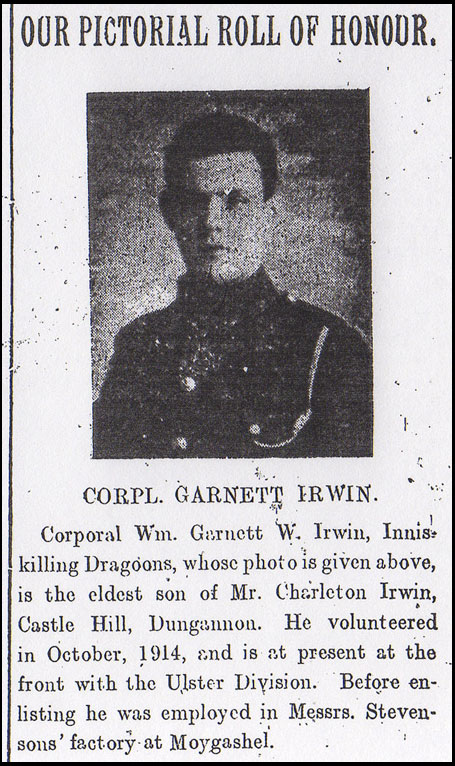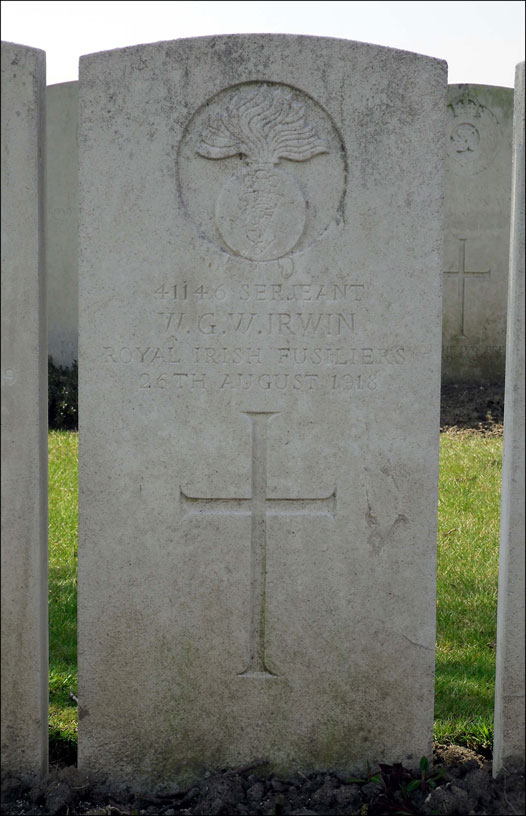![]() In memoriam
In memoriam ![]()
Sergeant William Garnett Wolsley Irwin

(Tyrone Courier, 27 April 1916)
William Garnett Wolsley Irwin was born on 30 July 1896 at Castle Hill, Dungannon, County Tyrone, the first of eight children of linen lapper Charleton Irwin and his wife Margaret (nee Hall). By 1911 he was living with his family at 7 William Street, Castle Hill, Dungannon, and working as an apprentice in the linen trade at the Stevenson factory at Moygashel. He was a member of the Dungannon Hunt Club and the local Masonic Lodge.
Irwin enlisted in the 6th (Inniskilling) Dragoons at Dungannon between 23 and 31 October 1914 (No. UD/83). His departure from Dungannon to join the squadron was mentioned in the Mid-Ulster Mail of 7 November:
Enthusiastic scenes were witnessed at Dungannon railway station on Monday morning, when six local members of the Ulster Volunteer Force left for Enniskillen to join the extra service squadron of the Royal Inniskilling Dragoons. They were Messrs. Jack Newell, Randall McManus, and Sandy Williamson, A Company, Dungannon Battalion U.V.F., and Messrs. W.J. Armstrong, Garnet Irwin, and Alexander Watt, of B Company. A very large crowd of friends and well-wishers had assembled to give them a hearty send-off, and as the train left the station loud cheers were raised and detonators exploded.
Irwin embarked for France with his squadron on 6 October 1915. At the time they were serving as divisional cavalry to the 36th (Ulster) Division.
In June 1916 the Inniskilling squadron came together with C and F Squadrons of the North Irish Horse to form the 2nd North Irish Horse Regiment, serving as corps cavalry to X Corps until September 1917 when the regiment was dismounted and most of its men transferred to the infantry. After a brief period of training at the 36th (Ulster) Division's Infantry Base Depot at Harfleur, Irwin was transferred to the Royal Irish Fusiliers on 20 September and soon after was posted to the 9th (Service) Battalion – renamed the 9th (North Irish Horse) Battalion. He was issued regimental number 41146 and posted to A Company. He probably saw action with the battalion during the Battle of Cambrai in November and December 1917 and perhaps also during the retreat from St Quentin and fighting near Ypres during the German spring offensive in March and April 1918.
On 24 August 1918 the 9th Battalion took part in in a successful attack on German lines north of Bailleul. Irwin was one of their 63 casualties – seriously wounded in the abdomen by shrapnel. He died two days later. On 5 September the Tyrone Courier and Dungannon News reported that:
Writing to the bereaved parents the Rev. Mr. [E.H.] Kennedy says that their son was buried in the military cemetery – a bright sunny spot in the cornfields. He trusts that God in His own good time will comfort them for the loss of their brave boy.
Sergeant Irwin and was buried at Arneke British Cemetery, Nord, France, grave III.D.2. His gravestone inscription reads:
41146 SERJEANT
W. G. W. IRWIN
ROYAL IRISH FUSILIERS
26TH AUGUST 1918
Another image which appears to be of Sergeant Irwin can be seen here.
Gravestone image kindly provided by Richard Evans. See his website Nelson, Glamorgan and the Great War http://www.nelson-ww1-memorial.org.uk. Press clipping sourced from the excellent website Dungannon War Dead Database, created by the Friends of the Somme, Mid Ulster Branch.
This page last updated 21 February 2023.

